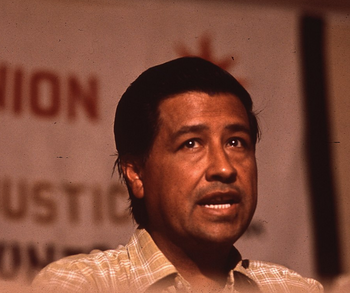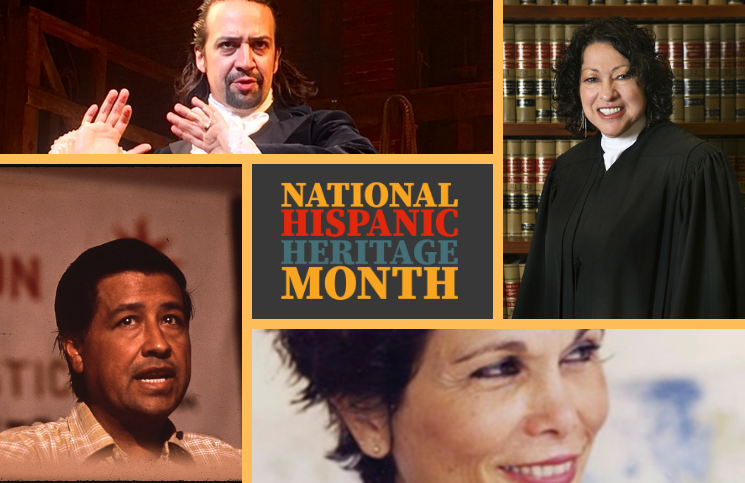by Joan Reissman
Hispanic American Heritage Month
If asked to identify a famous Hispanic American, almost everybody can name JLo. But many other Hispanic Americans have made contributions in many fields. September 15 to October 15 is Hispanic Heritage Month. Although many Latinx people have had long and winding roads to success, their struggles and determination resulted in enduring legacies. The cry Si se puede (yes we can), coined by Dolores Huerta, voices the grit and determination of the people described in this article.
César Chávez 1927-1993

César Chávez, best known for leading the United Farm Workers, was a towering figure in the American labor movement. The Delano grape boycott began in 1965 and remained in force until the United Farm Workers ended boycotts of grapes, lettuce and wine in 1978. I heard Chávez speak many years ago and I found his speech inspiring.
I spent many years doing work with UFW student branches. Many a Friday I spent protesting in front of a liquor store that sold Gallo wine. We protested weekly and so did the Gallo reps (who always wore trench coats).
César Chávez started the United Farm Workers because he had first-hand experience with their working conditions. After his father lost the farm in 1937, the family spent a decade working as migrant farm workers. The young Chávez saw how terrible working conditions for migrant farmworkers provided little income and no job security. If a worker was injured, he had no income outside of what his family could earn. Chávez left school after 8th grade to help out the family because his father had been injured. As a young boy, he read Gandhi and would later incorporate Gandhi’s philosophy of non-violent protest into his labor work.
After serving in the Navy during World War II, Chávez returned to the fields determined to improve the working conditions of migrant workers. He began his lifelong commitment to gaining better working conditions through non-violent protests, boycotts and hunger strikes. His first strike as a migrant worker came in 1948, but that was just the beginning.
Chávez joined his first labor organization, the Community Service Organization, in 1952. He traveled, made speeches, and eventually became the organization’s director. While working for the CSO, César met Dolores Huerta. He left to form his own organization (NFWA-National Farmworkers Association) with Huerta. This organization later became the UFW (United Farm Workers Union). Chávez and Huerta made a very good team. Chávez was the public face of the organization and Huerta was a skilled negotiator.
Chávez called the first grape boycott in 1965 and then followed with a national boycott against grapes in 1968. He later called for a national lettuce boycott in 1970. His boycotts, marches and hunger strikes were successful. The UFW and the Teamsters finally signed a jurisdictional agreement in 1977 and the UFW ended the grape and lettuce boycott in 1978.
César Chávez continued to fight for farm workers until his death in 1993. He posthumously received the Presidential Medal of Freedom.
Image source: This image is a work of an Environmental Protection Agency employee, taken or made as part of that person’s official duties. As works of the U.S. federal government, all EPA images are in the public domain.
Sonia Sotomayor 1954--

Sonia Sotomayor is one of our most distinguished Hispanic Americans. She is the first Hispanic American to serve as a Supreme Court justice. Justice Sotomayor’s father died when she was only 9 years old, but her mother made sure that her children prioritized education. After watching a Perry Mason TV episode, young Sonia decided to become an attorney.
She reflected in a 1998 interview, “I was going to college and I was going to become an attorney, and I knew that when I was ten. Ten. That’s no jest.” With her future goals in mind, Sotomayor studied diligently. She went to Yale Law School and after graduation started working as an assistant district attorney.
She left the District Attorney’s office for a job in a private firm but continued to do pro bono work with the Puerto Rican Legal Defense and Education Fund, the New York City Campaign Finance Board, and the State of New York Mortgage Agency. Politicians took note of her service and put forth her nomination to the U.S. District Court. She was the court’s youngest judge. Bill Clinton nominated Sonia Sotomayor to the U.S. Court of Appeals in 1997.
While serving in the District Court and Court of Appeals, she ruled on several important decisions. One of her most famous District Court rulings was Silverman v. Major League Baseball Player Relations Committee, Inc. She is credited with saving baseball by granting a temporary injunction against the MLB owners that ended the bitter baseball strike of 1994-95.
As a justice on the U.S Court of Appeals, Sotomayor frequently ruled to uphold individuals’ civil rights and frequently ruled in favor of the plaintiffs. In Correctional Services Corp. v. Malesko (1991) Sotomayor reversed a district court decision and said an inmate in a halfway house could sue the government contractor for allowing an employee to force the inmate to climb stairs even though the inmate had a heart condition. The Supreme Court later reversed this decision.
Justice Sotomayor has continued her concern for progressive issues as a Supreme Court justice. One of her most notable decisions was National Federation of Independent Business v. Sebelius, a decision that upheld the core of the Affordable Care Act. She also sided with the majority to uphold same sex marriage in all 50 states in Obergefell v. Hodges (2015). Other key progressive opinions include expansion of the Fourth Amendment with regard to privacy and search and seizure, and supporting lawsuits defending abortion rights and environmentalists.
A self-described “wise Latina” from the Bronx, Sonia Sotomayor has built a distinguished career as a staunch advocate for individual rights and a ringing voice for progressive causes on the current Supreme Court.
Image source: Part of a WhiteHouse.gov slide show, “Sotomayor Bio: Picutures from Throughout Judge Sotomayor’s Life“
According to the May 2009 White House copyright policy, “Except where otherwise noted, third-party content on this site is licensed under a Creative Commons Attribution 3.0 License.” No alternative licensing information is given for these photos, so they are assumed to be available under the Creative Commons Attribution 3.0 License.
Lin Manuel-Miranda 1980--

Most of us spend our college years hanging out with friends and cramming for exams at the last minute. Lin-Manuel Miranda wrote a musical at age 19 that won four Tony awards out of 13 nominations. That musical would take a about a decade to go from student musical to Broadway show. From the start it was clear that Lin-Manuel Miranda was on a mission.
Miranda was born in New York City to Puerto Rican parents. His mother is a clinical psychologist and his father is a political consultant. Although Miranda’s parents weren’t musicians or actors, they loved music, especially musicals. They shared their love of musicals with their children, who grew up listening to Broadway cast recordings.
Miranda wrote his first hit musical, In the Heights, when he was a sophomore at Wesleyan University. After working on the book and score for many years, the show finally reached Broadway in 2008. Although in many ways a traditional musical, Miranda’s authentic characters loosely based on his childhood and teenage experiences and his blend of Broadway style with Latin and popular genres attracted a wide audience.
After the success of In the Heights, Miranda went on vacation in 2008. For light vacation reading, he chose Ron Chernow’s 800-page book on Alexander Hamilton. Miranda was immediately enthralled with Hamilton’s story and felt that Hamilton was an 18th century version of a hip-hop hero. Miranda viewed Hamilton’s life as a “classic hip-hop narrative”– a rapper who used the power of words to climb out of poverty and obscurity into fame. Miranda “saw Hamilton’s rise as inseparable from his command of language,” Chernow said.
The genius of Hamilton lies in its unique and complex blend of genres used to convey meaning. Jefferson is portrayed as out of step with what needs to be done, so Miranda switches to jazzy style to suggest Jefferson’s detachment. . Miranda also uses the fast cadence of rap to tell a very complex story in two and a half hours. Many songs are packed with historical facts. For example, in the Battle of Yorktown Miranda narrates, ”We escort their men out of Yorktown They stagger home single file.” This means that Washington refused to let the British march out in formation after defeat.
The show was a huge success. Hamilton won the Pulitzer Prize and 11 Tony awards- one short of tying the record for the most wins.
Since his two great stage successes, Miranda has mainly worked with movies. He is supposedly working on another musical. He’s still only 42 years old.
Image: Lin-Manuel Miranda in the title role of his musical “Hamilton”, April 20, 2016, Date Taken: 20 April 2016, 16:50:21
Source: This image was originally posted to Flickr. Its license was verified as “cc-by-2.0” by the UploadWizard Extension at the time it was transferred to Commons. See the license information for further details
Julia Alvarez 1950 --

Julia Alvarez was born in New York City, but her family moved back to the Dominican Republic after her birth. The family lived in the Dominican Republic for ten years, but came back to the U.S. after her father’s involvement in a failed attempt to overthrow the dictator Rafael Trujillo. Alvarez writes about this traumatic experience in her poem Exile.
Since Julia was only ten when her family escaped to America, she felt pulled between two cultures. When the family first returned, she struggled with learning English and with prejudice. The cultural tug of war is a frequent theme in her work and the inspiration that drove her to become a writer. She said, “I consider this radical uprooting from my culture, my native language, my country, the reason I began writing… ‘Language is the only homeland,’ Czeslow Milosz observed; and indeed English, not the United States, was where I landed and sank deep roots.” But Alvarez did adjust to America. Despite prejudice and alienation she went to Middlebury College and achieved a very successful career as a writer. She has been writer- in- residence at Middlebury since 1988.
She has written poems and essays but her best-known works are two novels, How the Garcia Girls Lost Their Accents and In the Time of the Butterflies. Garcia Girls follows the characters’ troubles adjusting to a new environment after their arrival in America. Like Miranda’s In the Heights, the novel is loosely based on personal experience. Butterflies is about the Mirabal sisters, three of whom were murdered during the time of the Dominican dictator Trujillo.
Alvarez has won many awards including a National Endowments for the Arts grant, the Hispanic Heritage Award for Literature, the Lamont Prize (Academy of American Poets), and the Fitzgerald Award for Achievement in American Literature. She has never forgotten her parents’ sacrifices for social activism. She still honors their commitment. She and her husband run an organic coffee farm in the Dominican Republic. All profits go to literary programs.
Image source: https://literary-arts.org/ photo credit
All of these individuals have made lasting contributions to the world. We are grateful for their work and we will take this special time to celebrate their achievements. Si se puede!
Joan Reissman is a JFYNetWorks Instructional Specialist
Other posts authored by Joan can be found here.
HOW ARE WE DOING? In our pursuit to serve up content that matters to you, we ask that you take a couple of minutes to let us know how we’re doing? Please click here to be navigated to our JFYNet Satisfaction Survey. Thank you!





